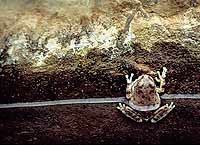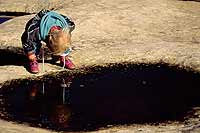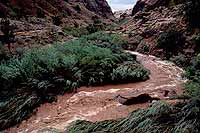 Many first-time visitors to Canyon Country are a bit surprised to know that in addition to all the flora and fauna that have adapted to the desert’s dry conditions, there are other species that depend upon, at the very least, the seasonal availability of water. These creatures are the amphibians: frogs, toads, and salamanders who live a double lifestyle.
Many first-time visitors to Canyon Country are a bit surprised to know that in addition to all the flora and fauna that have adapted to the desert’s dry conditions, there are other species that depend upon, at the very least, the seasonal availability of water. These creatures are the amphibians: frogs, toads, and salamanders who live a double lifestyle.
“Amphibian” is from a Greek word meaning “both kinds of life.” This phrase refers to the aquatic and terrestrial phases of these vertebrate’s life cycles.
These creatures start out as eggs, often deposited in large masses surrounded by gelatinous jelly called “frogspawn.” At times, the arrangement of these masses may indicate which species deposited them – spherical masses attached to underwater stems may be northern leopard frogs while long, double strands encased in a single jelly layer may belong to the hockey puck-sized Woodhouse’s toad.
After the eggs hatch, the aquatic larvae which have gills to breath underwater, develop rapidly. Some species, like the Great Basin spadefoot toad lay their eggs in ephemeral pools, the larvae racing against the clock to mature before the pool dries up, often within just a couple of weeks. 
Though there may be numerous larvae, some fall prey to predatory aquatic invertebrates such as dragonfly larvae, while others are eaten by fish, birds, snakes, and mammalian predators. Those that do survive will transform from tadpoles to adults and, in the process, undergo a transformation from breathing through gills to developing lungs to exist out of the water on land. Though frogs and toads stay close to water, they often burrow into soft soil to avoid the desiccating heat of summer or the cold of winter.
History aside, modern-day explorers in Canyon Country might encounter these amazing amphibians more through the night choruses of the male frogs and toads as they call to attract mates in the spring or in summer after heavy rains. Frogs and toads lack a diaphragm, so to project their calls, the male inflates his vocal sac, a membranous structure located below the chin, and this enlarged chamber helps to amplify the call as air passes back and forth from the lungs into the inflated vocal sac. The large disk-like tympanic “ears” may also aid in amplifying this sound which may be loud enough to be heard from far away.
 Red-spotted toads have a high-pitched trill while sandstone-colored canyon tree frogs with their suction-cup like toe pads produce more of a rolling, guttural call. Invasive bullfrogs emit a deep bellowing “Jug-a-rum.” Woodhouse toads produce a loud “Waaahh” call and the northern leopard frog produces a low-pitched guttural rattle advertisement call. The leopard frog, unlike the toads, has two vocal sacs on either side of its mouth which inflate. Tiger salamanders, which are also amphibians, skip this vocal courtship phase and breed in the quiet of early spring.
Red-spotted toads have a high-pitched trill while sandstone-colored canyon tree frogs with their suction-cup like toe pads produce more of a rolling, guttural call. Invasive bullfrogs emit a deep bellowing “Jug-a-rum.” Woodhouse toads produce a loud “Waaahh” call and the northern leopard frog produces a low-pitched guttural rattle advertisement call. The leopard frog, unlike the toads, has two vocal sacs on either side of its mouth which inflate. Tiger salamanders, which are also amphibians, skip this vocal courtship phase and breed in the quiet of early spring.
Many desert dwelling creatures such as bighorn sheep or collared lizards may steal the fauna limelight, the amphibians deserve some respect too. Their Some nights, the air may be filled with a mixture of calls by different species, a truly unique and “thrilling” desert experience.